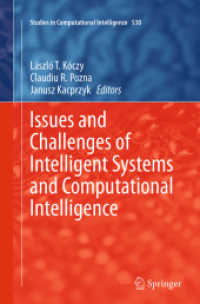Full Description
The main goal of this book is to offer the necessary knowledge and theoretical skills to all the clinicians performing digital EEG and aiming to implement quantitative EEG (qEEG) in daily practice. They will be able to understand the meaning and shall be capable to implement of some of the most popular numerical tools for analysis of EEG.
The work covers a broad spectrum from theoretical bases to the use of real cases encountered in clinical practice. It's structured in a step-by-step rise from the origins of EEG biosignals, following the mathematical basis of numerical toolbox and ending in real clinical cases numerically analysed. Therefore, such staff clinicians as residents will be familiarized with the use of these powerful methods, grasping the insight of its meaning in human pathology and being able to implement its own numerical toolbox.
The field of qEEG has enlarged significantly in the last decades and numerous mathematical methods have been described. Nevertheless,its use practically is not present at daily clinical practice. The unawareness of these methods and consequently the loss of confidence by clinicians can be at the root of the problem. On the other hand, many powerful methods are too complex to be used by clinicians. Nevertheless, authors state their personal experience that these tools are extremely useful in most of the cases appearing in routine and, therefore, they wish to share this experience with the rest of the neurophysiological community and with all allied professionals performing these methods. Although rigorous, this book has plenty of clinical cases and EEG recordings procedures.
Contents
Part I. Fundamentals and Method.- 1. Introduction to Electroencephalography.- 2. Electromagnetism and Biophysics of the EEG.- 3. Analogue and digital signals.- Part II. Practical application of qEEG.- 4. Analysis in the frequency domain.- 5. Measurements of synchronization.- 6. A proposal for an analytic system: CRANE.- 7. Epilepsy.- 8. Intensive Care Unit patients.- 9. Encephalopathies.- 10. Dementias and Psychiatric pathologies.- 11. Sleep.- 12. Other neurological pathologies.- 13. The future of qEEG in clinics.- Part III. Mathematical Topics.- 14. Linear algebra: vector analysis.- 15. Lineal algebra: matrices.- 16. Brief reminder of calculus.- 17. Differential equations.- 18. Complex numbers.- 19. Laplace transform, LTI systems and convolution.- 20. The z-transform.- 21. Trigonometry.- 22. Probability.








